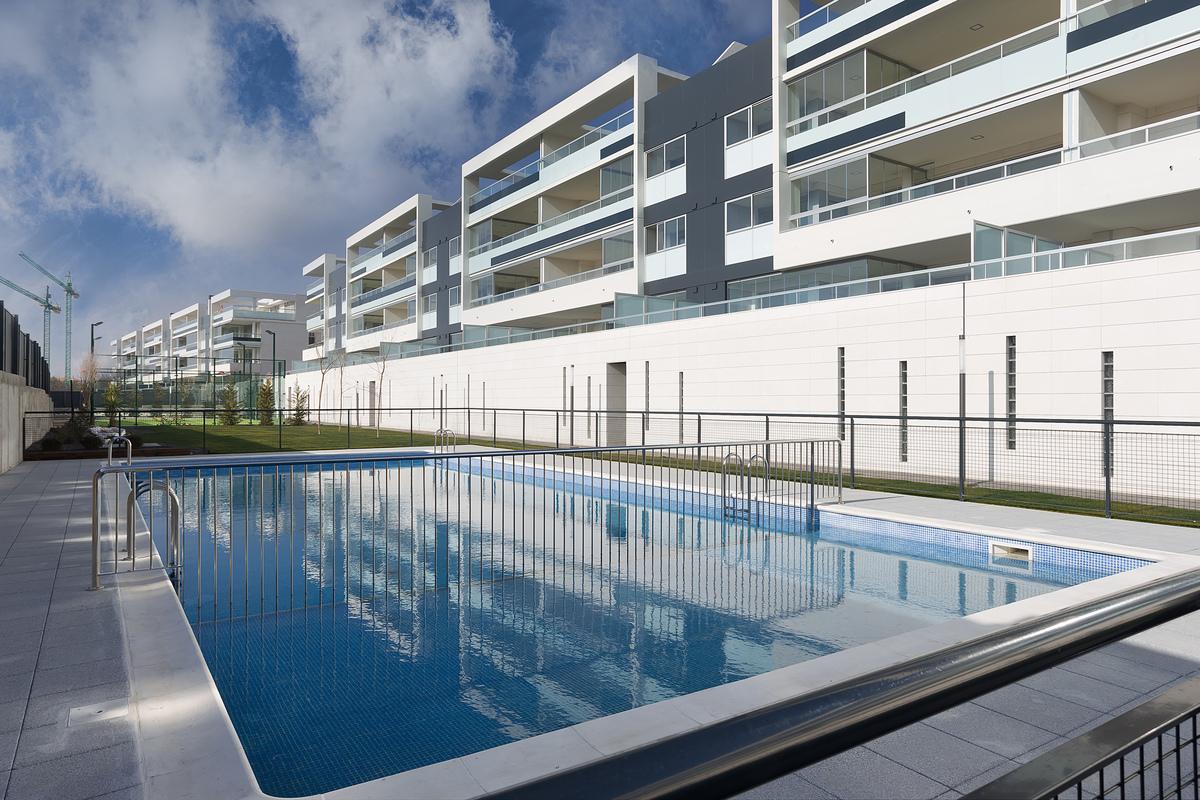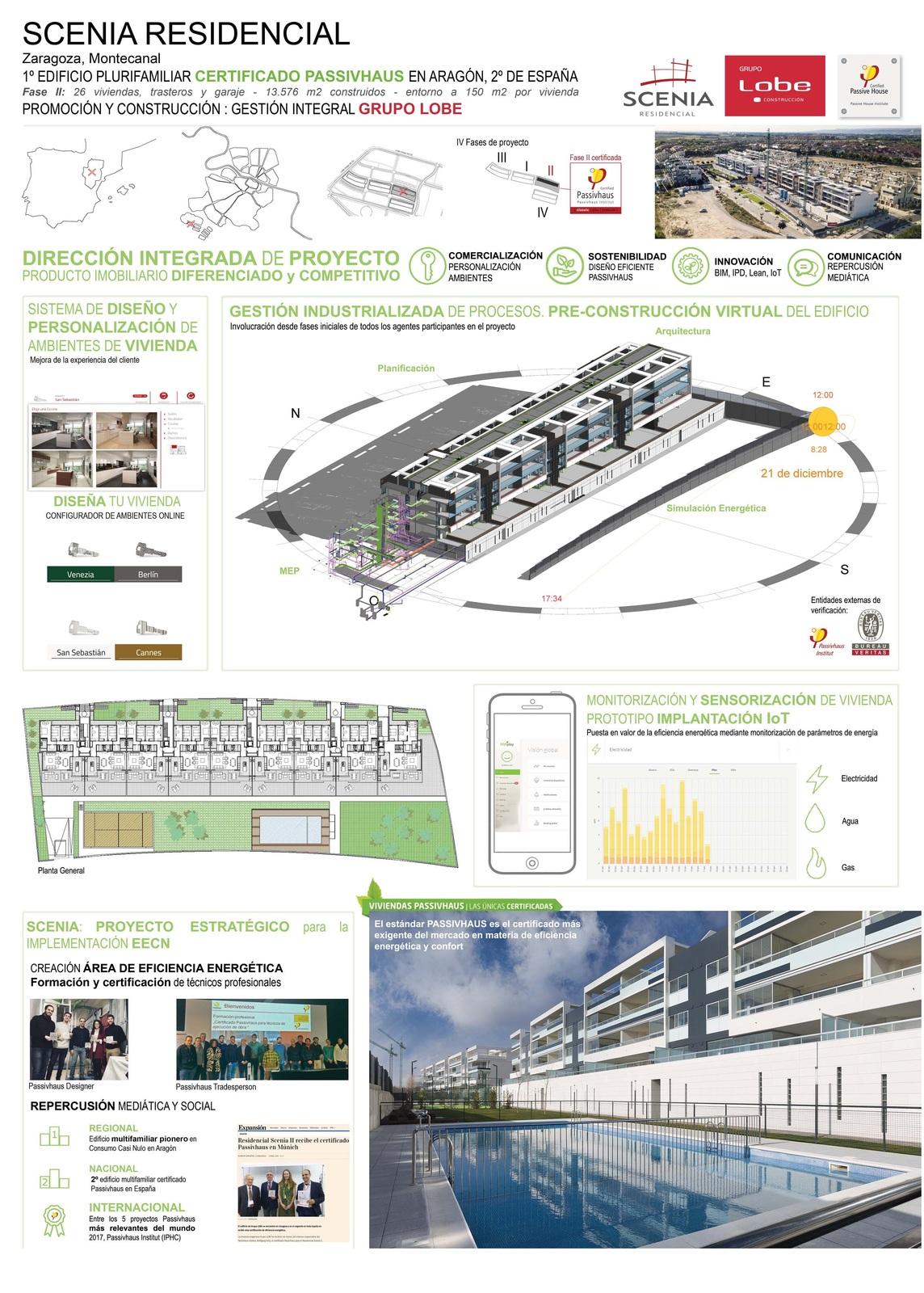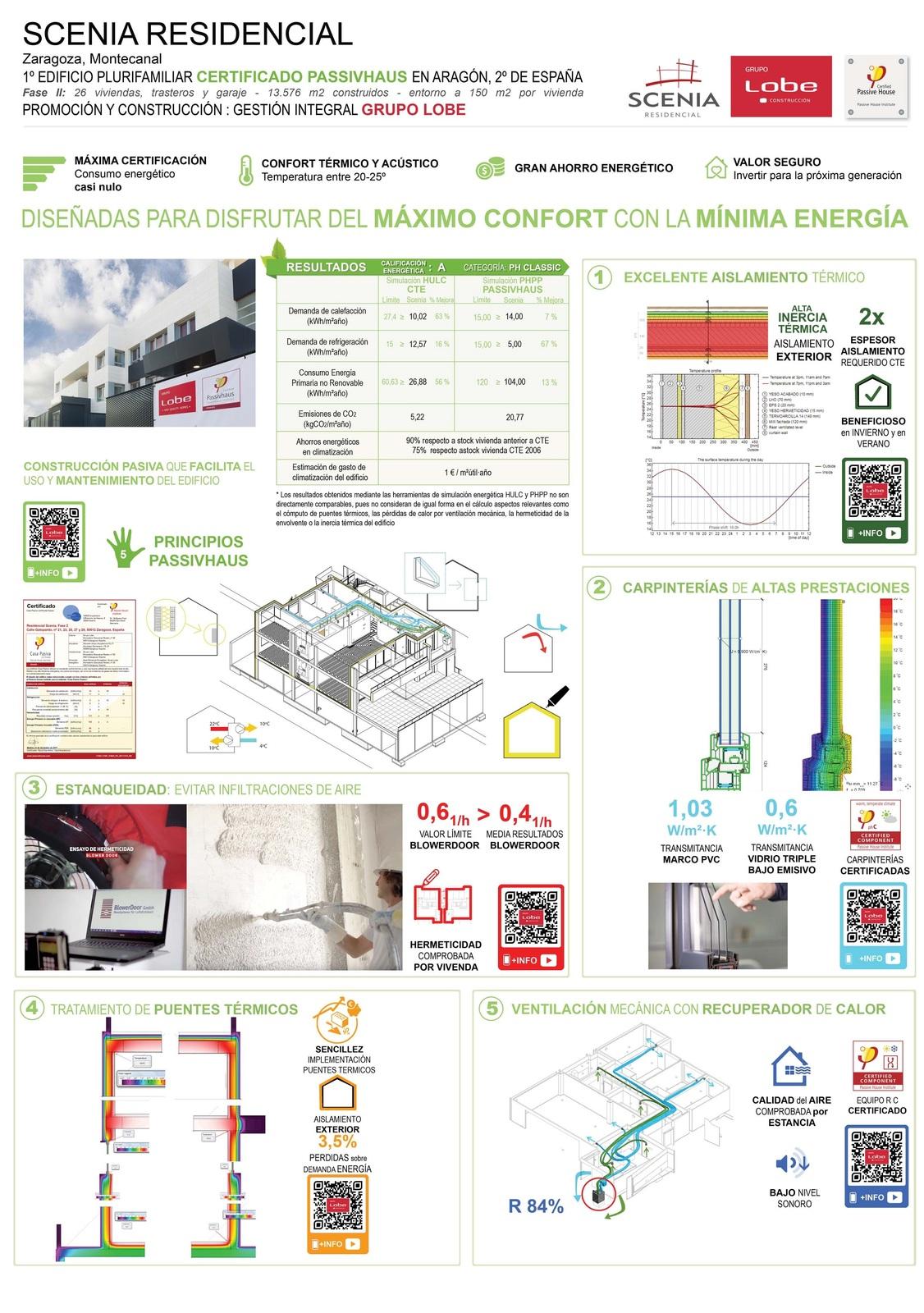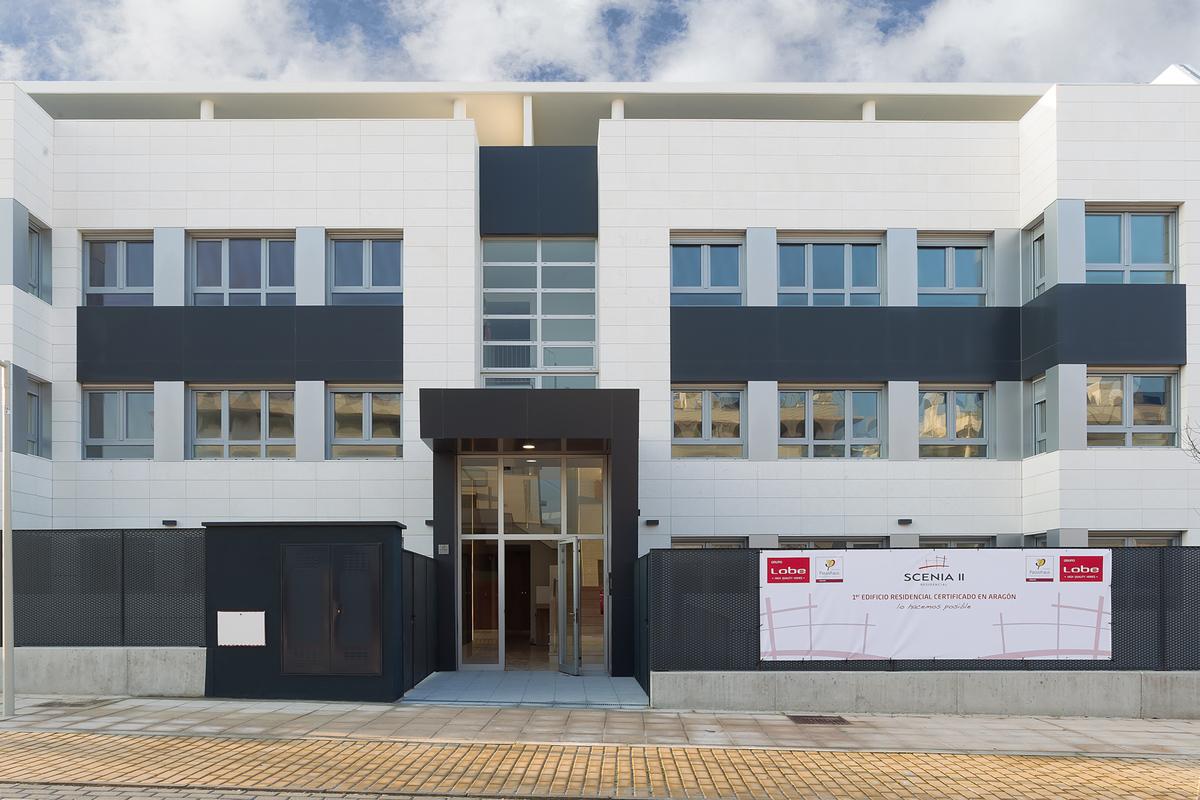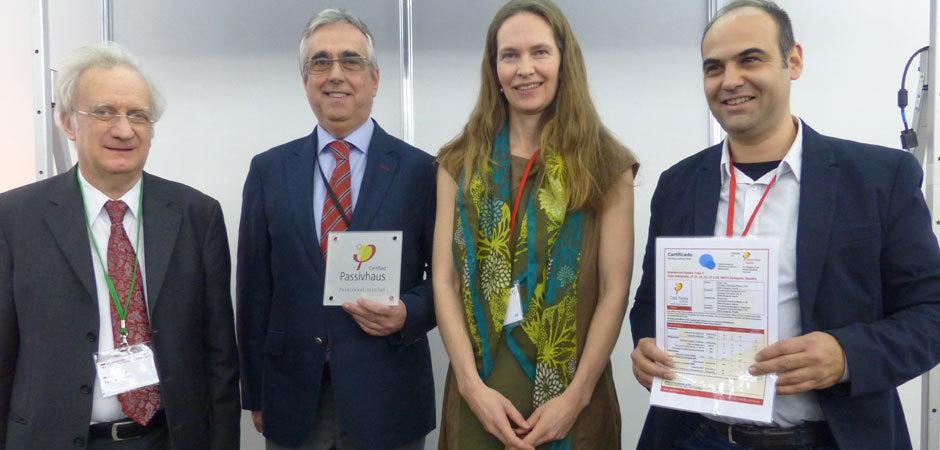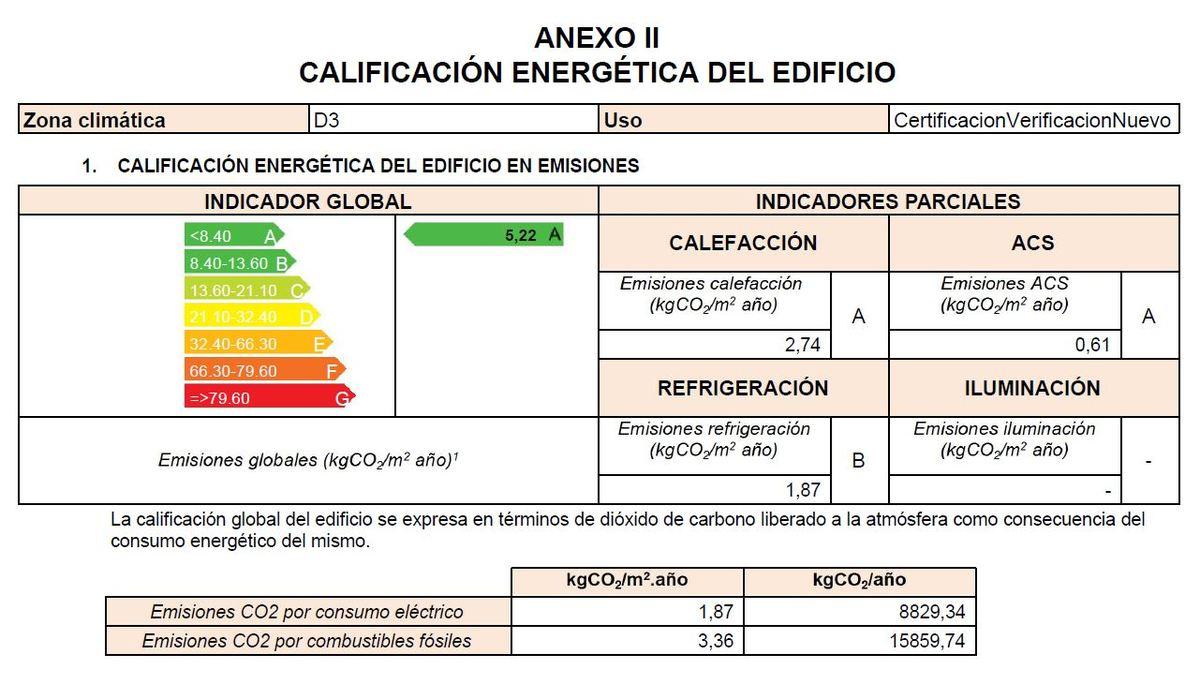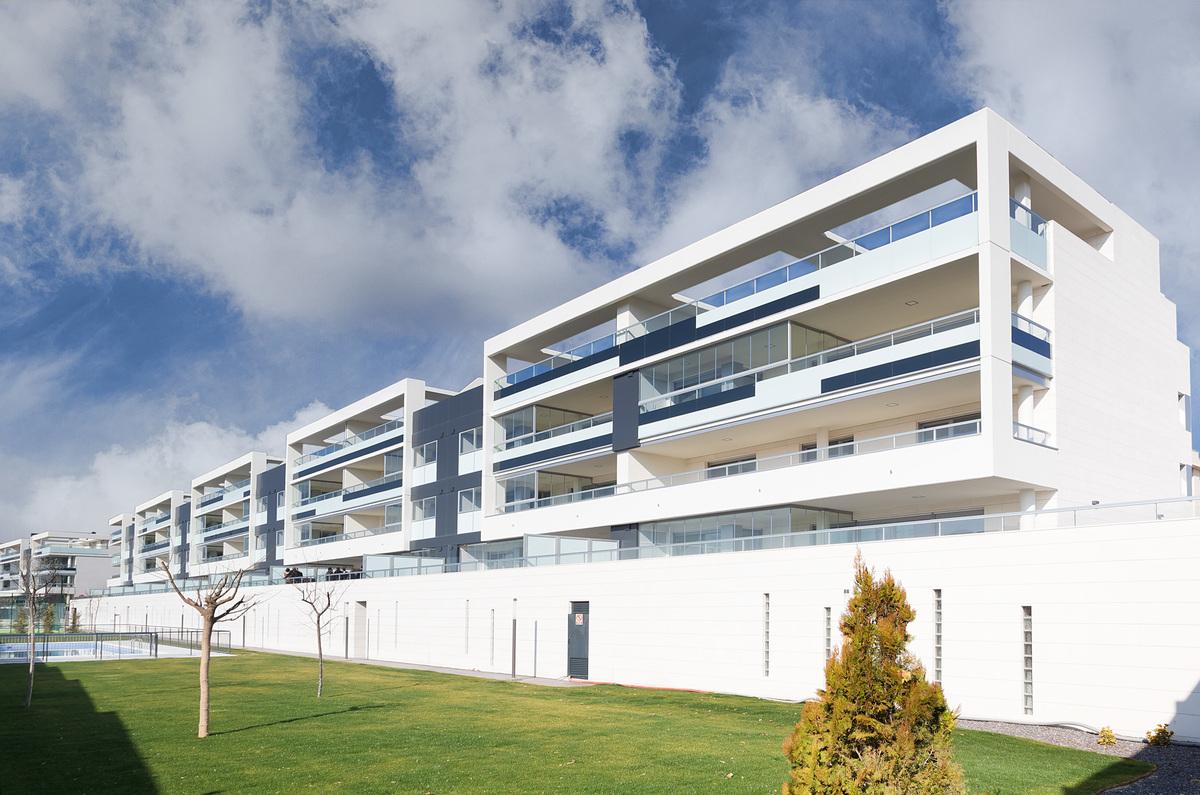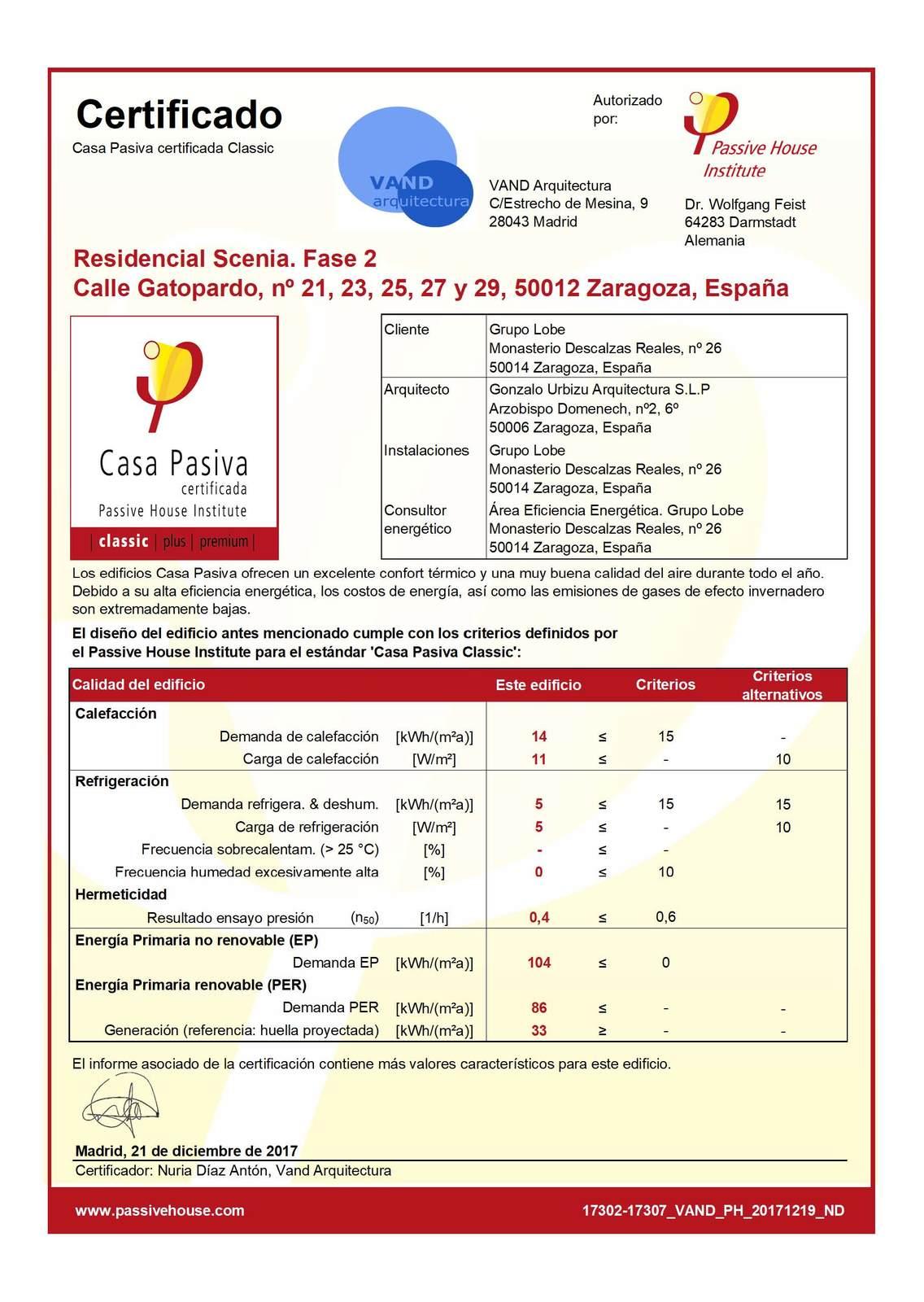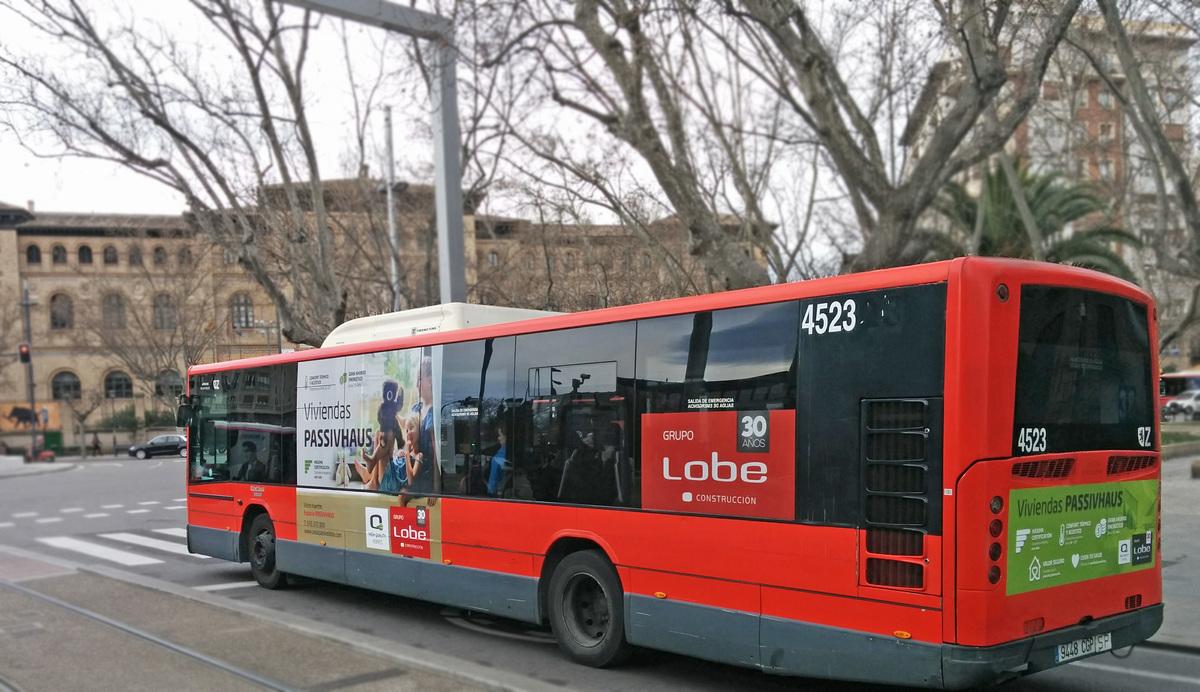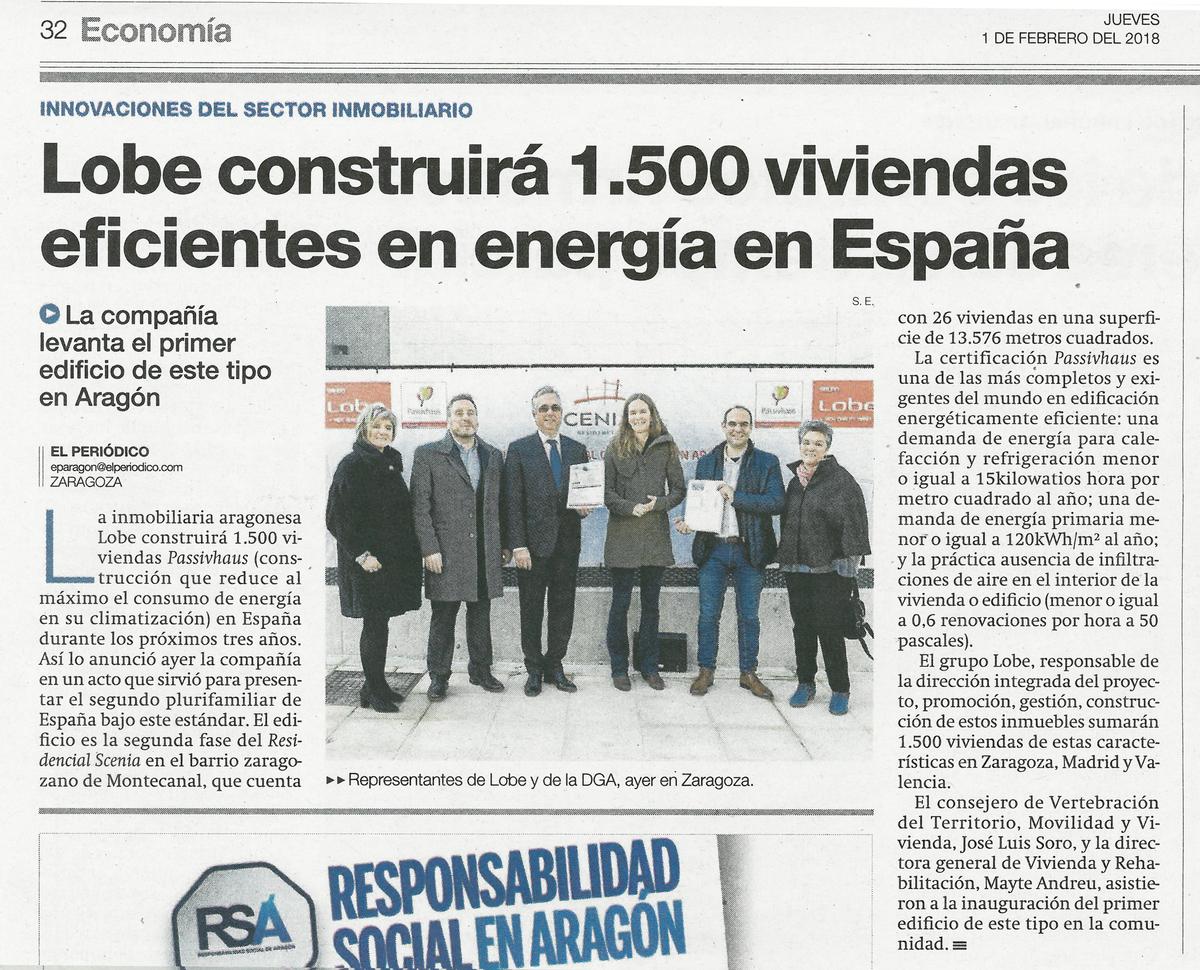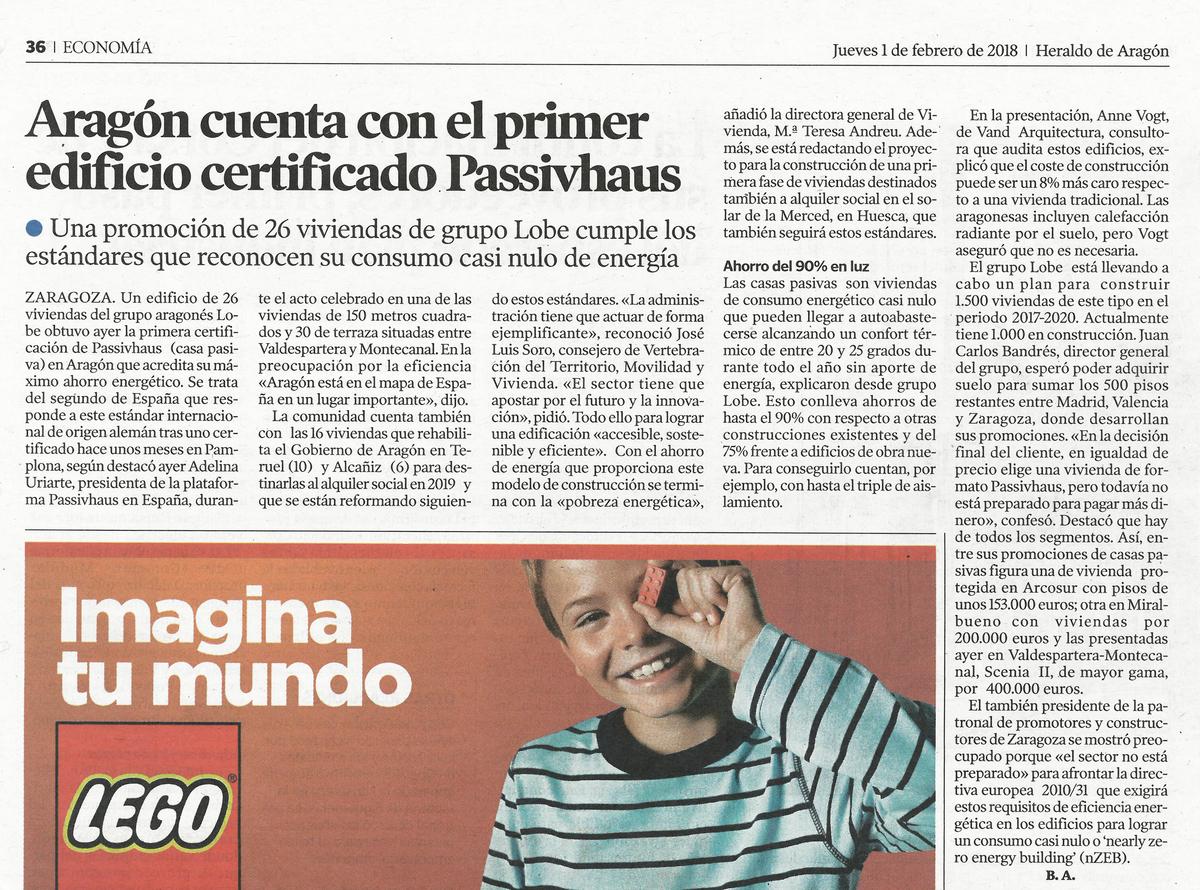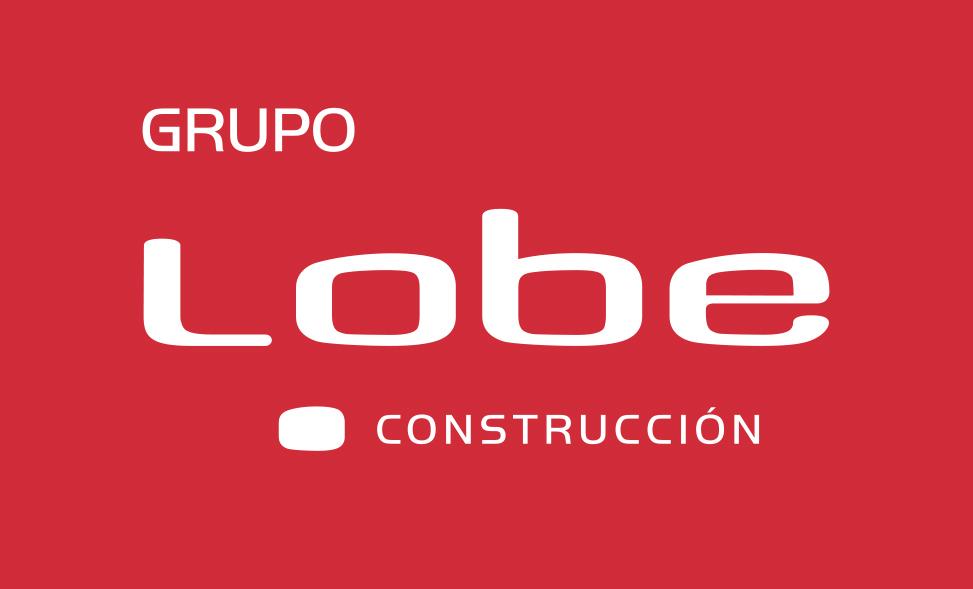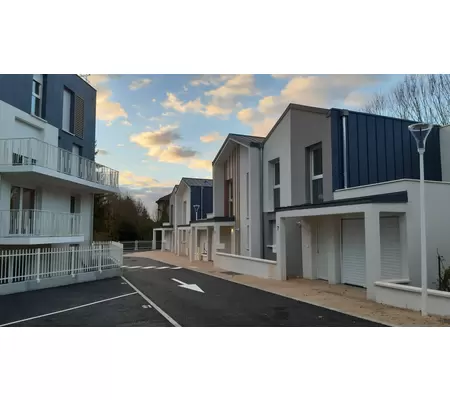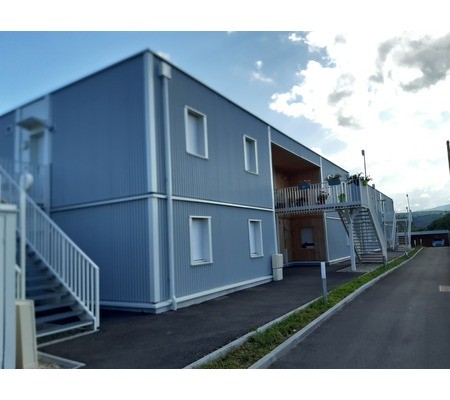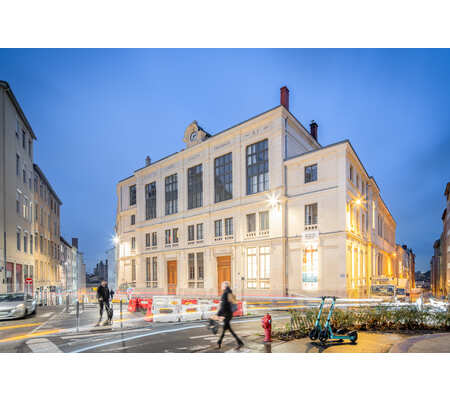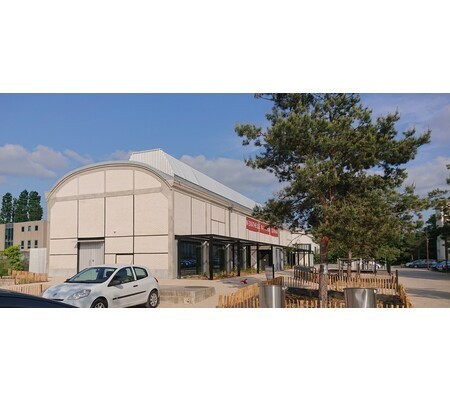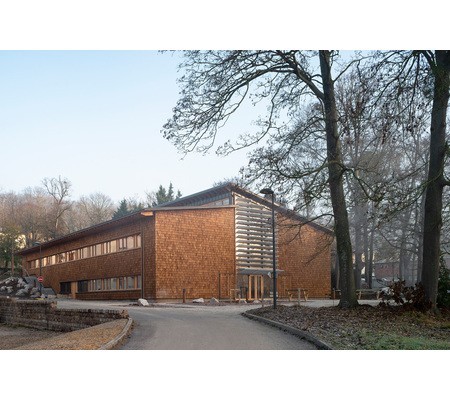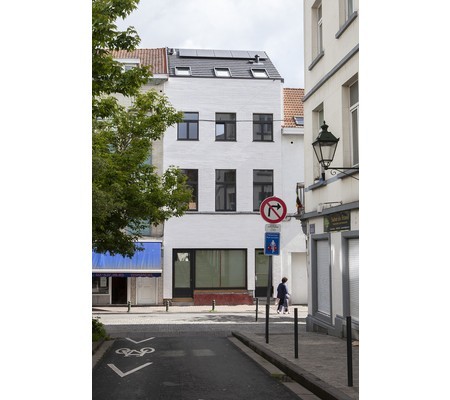Residential Scenia. Multi-family Passivhaus building in Mediterranean climate (Zaragoza, Spain)
Last modified by the author on 08/06/2018 - 16:19
New Construction
- Building Type : Collective housing > 50m
- Construction Year : 2017
- Delivery year : 2018
- Address 1 - street : 50012 ZARAGOZA, España
- Climate zone : [Csa] Interior Mediterranean - Mild with dry, hot summer.
- Net Floor Area : 4 150 m2
- Construction/refurbishment cost : 3 016 948 €
- Number of Dwelling : 26 Dwelling
- Cost/m2 : 726.98 €/m2
-
Primary energy need
104 kWhpe/m2.year
(Calculation method : )
Introduction
Scenia (phase II) is a collective residential project of new construction, with 26 exclusive homes and garage with a total of 13,576 m2 built located in one of the best areas of Zaragoza, Valdespartera-Montecanal with common garden area, pool and paddle court.
Through a coherent architecture with its climatic location, it puts in value the energetic efficiency in construction. On the other hand, it offers large homes around 150 m2 of useful space with very bright spaces and very large terraces that incorporate greenhouses allowing them to be enjoyed during all seasons of the year.
A strategic project for the implementation of EECN
It is at the same time a strategic project for the Lobe group that has allowed prototyping the promotion of high energy efficiency and starting the strategic plan for the implementation of the almost zero consumption building through passivhaus standard in all real estate projects underway, completely transforming the business organization through the generation of an internal area of energy efficiency responsible for the energy design of the buildings, the continuous training of its technicians and subcontractors and other changes in the management of the projects and the execution processes that allow the business group to anticipate the directive of obligatory fulfillment of the year 2020 turning into a dynamizer of the sector in the field of the construction energetically efficient inside his scope of performance.
Project designed, built and certified by passivhaus standard, has been recognized at the 22nd iPHC (Passive House International Conference) in Munich by the Passivahus Institut and its founder, Wolfgang Feist, as one of the most efficient buildings in the world built by this standard. Scenia II is the first multifamily passivhaus certified building in Aragon and the second in Spain.
See more details about this project
http://www.residencialscenia.es/http://www.grupolobe.com/index.php/passivhaus/
Data reliability
3rd part certified
Contractor
Construction Manager
Stakeholders
Other consultancy agency
AREA DE SOSTENIBILIDAD Y EFICIENCIA ENERGÉTICA- GRUPO LOBE
C/ Monasterio Descalzas Reales 26 Polígono Alcalde Caballero 50014 Zaragoza • 976 734 142
http://www.grupolobe.com/index.php/passivhaus/Project energetic design, justification and passivhaus standard
Developer
GRUPO LOBE - VALDEJUNQUERA S.L.
976 372 000
http://valdejunquera.com/Contracting method
Lump-sum turnkey
Owner approach of sustainability
Sustainable approach to the energy and energy efficiency section of the building, building through international standards such as Passivhaus, which minimizes the demands for climate control and the integration of renewable energies to reduce the rest of the building's energy consumption. Energy consumption in residential and commercial buildings continues to represent approximately 40% of total final energy consumption and 36% of the total CO2 emissions of the European Union, with the consequent effect on climate change. Given this scenario, there is a growing collective interest to act in a responsible manner from the environmental point of view, taking into account the rational use of energy and the improvement of the quality of life of people. In this sense, Grupo Lobe wants to have a key and differentiating role, assuming these challenges as its own and incorporating them into its business model, with the ambition and commitment to become a company that promotes the construction of high energy efficiency and low carbon.
STRATEGIC ENERGY EFFICIENCY PLAN
In order to respond to this commitment, during this year the Strategic Energy Efficiency Plan adopted in 2015 has been put into practice, which proposes the promotion of highly efficient buildings, with almost zero energy consumption (nZEB) and which anticipates the European Directive 2010/31 / EU of mandatory compliance for the year 2020, thus exceeding the normative requirements recently published in the Basic Energy Saving Document of the Technical Building Code (CTE) of June 2017, relating to the definition of the almost zero consumption building.
The implementation of the building of almost zero consumption in the promotions has been made by adopting the German construction standard Passivhaus, the world's most demanding certificate in terms of comfort and energy efficiency. This standard has already been taken as normative reference by other countries of the European Union. Passivhaus guarantees energy savings of up to 90% compared to existing buildings and requires greater rigor in quality control and execution of work, through the application of 5 basic principles: high degree of insulation in the thermal envelope, high performance in carpentry and glazing, waterproofing solutions that reduce air infiltration, thermal bridge free design and mechanical ventilation with heat recovery. Given the versatility of the passivhaus standard, not establishing a method or a constructive system, and leaving this choice at the discretion of the designer, it has been possible to implement constructive solutions of local tradition that meet the requirements and limitations defined in the standard regardless of the system constructive employee.
Likewise, the Lobe group continues to carry out constant research into new construction procedures that involve a substantial improvement in the energy performance of buildings, advocating innovative industrialized methods that allow environmental benefits through the reduction of energy consumption and CO2 emissions during the construction processes.
Additionally, and despite the fact that the current CTE regulations do not contemplate it, there are more and more arguments in favor of working on the tightness of the building envelope as required by the standard: minimize energy losses, reduce the risk of interstitial condensation or avoid the entry of aggressive external agents or contamination.
The energy performance of the facilities is considered one more factor to take into account in the improvement of the energy efficiency of the building, consequently, the design of thermal installations that work at a low temperature and that incorporate high performance equipment such as aerotermia guaranteeing great energy savings and complementing the low energy demand of a building designed by passivhaus criteria. At the same time, unique advances are promoted in one of the future challenges, the integration of renewable energies, such as solar thermal energy or photovoltaic solar energy that will increase energy savings and favor local energy production.
1500 VIVIVENDAS ECCN
At this moment Grupo Lobe is pioneering the promotion and construction of the first residential buildings in height through the Passivhaus standard in the community of Aragón and other communities such as Madrid or the Valencian community, establishing itself as a reference company for the sector.
In this way, the LOBE Group feels the responsibility to continue generating value, confidence and commercial differentiation through increasingly sustainable practices, responding to a growing demand in society. Their determination to respect the environment and change the energy model for the benefit of society is reflected in the prioritization of energy efficient and sustainable construction techniques and in working under standards or internationally recognized labels that value not only the consumption of energy in the use phase, but also in its construction phase, including other aspects such as the integral management of the water cycle.
In order to evaluate the effectiveness of these techniques, the implementation of Technologies that allow to measure and value the comfort, environmental, energy, water and on-site energy generation parameters of buildings is adopted.
Architectural description
The project proposal responds to the requirements of the residential area plan developed under bioclimatic criteria, respecting their areas of movement, orientation, setbacks, flights, maximum heights, occupancy and buildability indicated by regulations that facilitate the achievement of a building with very high energy efficiency by putting value on its passive architecture.
The project is organized in a single block with predominance of its facades in the North-South components, with dwellings arranged in a linear scheme of two dwellings per communication core optimizing space and its functionality. The houses are distributed by differentiating the area from night to day, with terraces of great depth in the South orientation and the incorporation of collector galleries in this same orientation that contribute to minimize the heating demands. The general envelope of the building is set by a ventilated facade finished in white very beneficial for the summer period in the climatic location of Zaragoza. A very differentiated treatment has been made between the North and South facades, based on the needs of access to the sun and solar blockade that contribute to the formal and plastic expression of the building.
If you had to do it again?
Reduce systems that depend on fossil fuels, betting on electricity as the main source of primary energy. Increase the installation of renewable energies, mainly solar photovoltaic. Include water efficiency mechanisms. In the following projects the passivhaus standard is maintained with proposals for integration of EERR to bet on shared self-consumption and distributed generation.
Energy consumption
- 104,00 kWhpe/m2.year
- 182,00 kWhpe/m2.year
- 123,00 kWhfe/m2.year
Envelope performance
- 0,22 W.m-2.K-1
- 2,50
- 0,41
Systems
- Condensing gas boiler
- Solar thermal
- Condensing gas boiler
- Solar Thermal
- Reversible heat pump
- Nocturnal ventilation
- Free-cooling
- Double flow heat exchanger
- Solar Thermal
- 72,70 % de la demanda total de ACS
Smart Building
GHG emissions
- 5,22 KgCO2/m2/year
Water management
Indoor Air quality
Comfort
Product
Zehnder ComfoAir 350
Zehnder
+34 935824595
https://www.zehnder.es/
The comfort ventilation unit Zehnder ComfoAir 350 has been developed for use in high-rise residential and commercial buildings. It combines maximum comfort with easy control, high efficiency and flexible integration in technological devices for housing. The CA350 heat recovery fans can move 370 m³ / h of air at an external pressure of 100 Pa.
Efficiency
The counter-current integrated exchanger achieves an efficiency of up to 95%. For the comfort of the user this means the absence of unpleasant air currents, since the supply air, even at freezing temperatures, is heated practically up to room temperature.
Correct operation
Vidrios Guardian Glass
GuardianGlass - Inrialsa
GuardianGlass: +34 948 817 239 - Inrialsa : +34 941 449 199
https://guardianglass.com/ - http://www.inrialsa.com/es/
Triple glass that incorporates solar control sheets to limit the transmission of sunlight to the interior (solar factor g = 46.8, light transmittance of 69.6%) and low emissive to reflect the infrared into the interior of the house, optimizing its behavior in the presence of heat losses in this range (Uglass = 0.6 W / m2K). Filled chambers 90% argon 10% air.
Correct behavior
Monitoring and sensorization IoT

EFOR Internet y Tecnología
976 46 76 76
https://www.efor.es/
Accessibility of data from application for mobile devices and internet. Fifthplay.
The following parameters are monitored:
Interior temperature (per stay)
Outside temperature
Relative humidity (per stay)
Disaggregated electrical consumption. Kitchen (appliances), ventilation, AACC and general consumption.
It allows the valorisation of energy efficiency from the monitoring and sensorization of energy and environmental parameters. Obtaining and continuous improvement of systems and uses based on real data of the constructed building.
Health guarantee: Control of compliance with optimal temperature levels (20ºC-25ºC), relative humidity (50%)
Data accessibility: Consumption reading application through mobile devices and internet.
Awareness: Adoption of responsible consumption habits by the user.
Economic and energy savings: Real information to detect and correct inefficiencies.
Research and development: Innovative data collection and analysis project in the first multi-family building built EECN and passivhaus certificate in the community of Aragon.
Construction and exploitation costs
- 3 016 947 €
Urban environment
Residencial Scenia has an architecture consistent with its urban location: it is located within the so-called "Ecocity of Valdespartera", a partial plan for sustainable urban planning. The urban layout of the area addresses environmental aspects such as the orientation of the buildings, the separate collection of wastewater and rainwater that are reused in the irrigation of green areas or the pneumatic network of separative waste collection, which works with energy electricity from renewable energies.
Land plot area
5 381,00 m2
Green space
2 178,75
Parking spaces
The building includes 52 parking spaces
Building Environmental Quality
- energy efficiency
Reasons for participating in the competition(s)
Building Scenia
The simplicity in the implementation of techniques and local constructive solutions has been sought to achieve the passivhaus standard without compromising the economic profitability of the promotion. With this aim, high levels of insulation have been incorporated into the thermal envelope with low thermal transmittances of U = 0.22-0.23 W / (m2K), high performance in the openings through high performance carpentry with U = 1.0 W / (m2K) and glasses of low thermal transmittance with U = 0.6 W / (m2K). We have tried a construction free of thermal bridges trying and justifying all existing cases to ensure compliance with energy losses, risk of surface condensation, appearance of mold and temperatures of comfort getting energy losses by thermal bridges over the global the demand only represent 3.5%. It is counted on the other hand with 82% efficiency in the heat recovery of the mechanical ventilation installation once installed, guaranteed by a continuous ventilation of the fully controlled air due to the high level of sealing of the building.
The minimum contribution of energy necessary to guarantee comfort conditions has been solved by active measures of high efficiency such as the collective installation of heating with condensing boiler and terminal units by underfloor heating that allow working at low temperature or high air conditioning equipment efficiency. The reduction in the consumption of electricity is also addressed by the incorporation of high efficiency appliances and LED lighting.
Likewise, renewable energy integration has been carried out to cover a contribution of 70% of the ACS demand through collective solar thermal installation.
As a result, a good energy balance has been obtained, where in addition to applying the principles of the standard, other general passive design criteria have been incorporated consistent with the climate location of Zaragoza that guarantee a high efficiency of the building in the Mediterranean climate and especially in the case of refrigeration.
Results
- Passivhaus classic certification
14 Kwh / (m2a) in heating demand, 11 (w / m2) of heating load, 5 kWh / (m2a) of heating demand, 5 (W / m2) of refrigeration load, watertightness 0.4 r / h and non-renewable primary energy consumption (passivhaus criterion) of 104 Kwh / (m2a). The energy reference surface of the building amounts to 4150 m2
- Energy CTE
10.02 Kwh / m2a) in demand for Heating, 12.57 Kwh / (m2a) in cooling demand, 26.88 Kwh / (m2a) in non-renewable primary energy consumption and 5.22 KgCO2 / (m2a)
The estimation of costs for the demand of air conditioning of the building considering a slogan of 20 ºC in cold period and 25 ºC in warm period is estimated in 1 € / m2 per year which supposes savings of up to 90% in comparison with constructions previous to CTE and up to 75% against construction CTE 2006.
The building has the installation of a prototype of IoT in one of the houses that allows the monitoring of temperatures and energy consumption in real time, which allows to value the energy efficiency of the building and corroborate design hypotheses to submit them to an improvement continues in the projects to be built in the coming years through this standard.
Building candidate in the category

Energía & Climas Temperados

Edificio Inteligente





